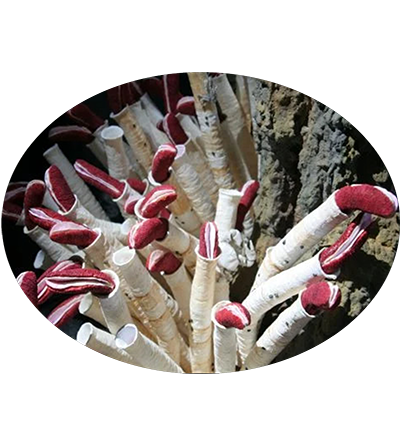
Riftia pachyptila, commonly known as the giant tube worm, is a marine invertebrate in the phylum Annelida. It inhabits hydrothermal vent ecosystems on the Pacific Ocean floor, where temperatures range from 2 to 30 °C. This species can tolerate extremely high hydrogen sulfide levels and relies entirely on symbiotic sulfur-oxidizing bacteria housed in its trophosome for nutrition. These worms can grow up to 3 meters in length, with tubular bodies reaching a diameter of 4 cm, making them one of the most iconic organisms in deep-sea vent ecosystems.
Animalia (Kingdom); Annelida (Phylum); Polychaeta (Class); Sedentaria (Subclass); Canalipalpata (Infraclass); Sabellida (Order); Siboglinidae (Family); Riftia (Genus); Riftia pachyptila (Species)
Riftia pachyptila Jones, 1981
1. Jones M L. Riftia pachyptila, new genus, new species, the vestimentiferan worm from the Galapagos Rift geothermal vents (Pogonophora)[J]. 1981. (Jones et al., 1981)
Galapagos Rift, Rose Garden geothermal vent 0.8042 (0° 48' 15" N) -86.2247 (86° 13' 29" W), 2,450 meters
| Species | Phylum | Common Name | Ecosystem | Depth | Habitat | NCBI Taxonomy ID |
|---|---|---|---|---|---|---|
| Riftia pachyptila | Annelida | Cold seep, Deep sea, Vent field | 2,514 | hydrothermal vent site Tica, East Pacific Rise (Alvin dive 4839, 9°50.398′N, 104°17.506′W) | 6426 |
| Genome Assembly | Genome Size | Assembly level | Released year | WGS accession | Submitter | BioProject | BUSCO completeness (%) | Scaffold/Contig N50 (kb) | GC content (%) | Repeat Rate (%) | Gene Number |
|---|---|---|---|---|---|---|---|---|---|---|---|
| - | 554Mb | Contig | 2023 | - | QUEEN MARY UNIVERSITY OF LONDON | PRJEB55047 | 99.37 | 2870 | 40.49 | 29.99 | 37,037 |
| Title | Journal | Pubmed ID |
|---|---|---|
| Distinct genomic routes underlie transitions to specialised symbiotic lifestyles in deep-sea annelid worms | nature communications | 37198188 |
| Gene ID | Description |
|---|---|
| RPACG04827.1 | |
| RPACG04827.2 | |
| RPACG04827.3 | |
| RPACG04828.1 | |
| RPACG04829.1 | |
| RPACG04830.1 | |
| RPACG04831.1 | |
| RPACG04832.1 | |
| RPACG04833.1 | |
| RPACG04834.1 | IONOTROPIC GLUTAMATE RECEPTOR |
| RPACG04835.1 | FI01416P |
| RPACG04836.1 | FLAVIN MONOAMINE OXIDASE |
| RPACG04837.1 | BIOGENESIS OF LYSOSOME-RELATED ORGANELLES COMPLEX 1 SUBUNIT 5 |
| RPACG04838.1 | REGULATING SYNAPTIC MEMBRANE EXOCYTOSIS PROTEIN |
| RPACG04839.1 | REGULATING SYNAPTIC MEMBRANE EXOCYTOSIS PROTEIN |
| RPACG04840.1 | DISCOIDIN, CUB, EGF, LAMININ , AND ZINC METALLOPROTEASE DOMAIN CONTAINING |
| RPACG04841.1 | ZINC FINGER PROTEIN |
| RPACG04842.1 | RIBOSE-PHOSPHATE DIPHOSPHOKINASE FAMILY MEMBER |
| RPACG04843.1 | UBIQUINOL-CYTOCHROME C REDUCTASE COMPLEX 14 KD PROTEIN |
| RPACG04844.1 | PHOSPHATIDYLINOSITOL KINASE |
| RPACG04845.1 | |
| RPACG04846.1 | PROTEIN CBG16428 |
| RPACG04847.1 | HCLS1-BINDING PROTEIN 3 |
| RPACG04848.1 | |
| RPACG04849.1 | HEAVY PROTEIN, PUTATIVE-RELATED |
| RPACG04850.1 | ANTIBIOTIC RESISTANCE PROTEIN MCBG |
| RPACG04851.1 | ZINC FINGER PROTEIN |
| RPACG04852.1 | |
| RPACG04853.1 | |
| RPACG04854.1 | TRANSLOCATION ASSOCIATED MEMBRANE PROTEIN |
| RPACG04855.1 | PH DOMAIN-CONTAINING PROTEIN |
| RPACG04856.1 | POLYCYSTIN FAMILY MEMBER |
| RPACG04857.1 | |
| RPACG04858.1 | |
| RPACG04859.1 | |
| RPACG04860.1 | |
| RPACG04861.1 | - |
| RPACG04862.1 | |
| RPACG04863.1 | POLYCYSTIN-1 |
| RPACG04864.1 | |
| RPACG04865.1 | |
| RPACG04866.1 | FIBRONECTIN TYPE-III DOMAIN-CONTAINING PROTEIN-RELATED |
| RPACG04866.2 | |
| RPACG04867.1 | |
| RPACG04868.1 | |
| RPACG04869.1 | PERILIPIN 4 |
| RPACG04870.1 | |
| RPACG04871.1 | STG PROTEIN |
| RPACG04872.1 | |
| RPACG04873.1 |

